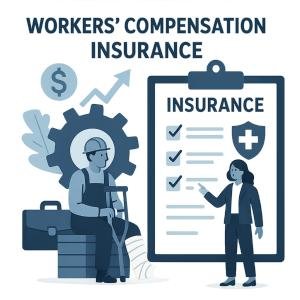
Affordable Workers’ Comp—Healthcare Staffing
September 11, 2025
Mobile Patrol Security Guard Workers’ Comp Insurance—Coverage Essentials
September 11, 2025In the complex landscape of mergers and acquisitions (M&A), thorough due diligence is paramount to identifying and mitigating potential risks. Among these, workers’ compensation liabilities frequently enough represent a meaningful but sometimes overlooked exposure that can impact the financial and operational health of the transaction. This article delves into the critical role of due diligence on workers’ comp liabilities, outlining key considerations, best practices, and strategies to ensure that acquirers and stakeholders are fully informed and prepared to address these obligations. Understanding these elements is essential for achieving a successful transaction and safeguarding against unforeseen costs.
Table of Contents
- Mergers and Acquisitions Workers Compensation Risk Assessment
- Identifying and Quantifying exposure in Workers Comp Liabilities
- strategies for Mitigating Workers Compensation risks During Due Diligence
- Best Practices for Integrating Workers comp Obligations Post-Acquisition
- Q&A
- To wrap It Up
Mergers and Acquisitions Workers Compensation Risk Assessment
Successfully navigating the complexities of mergers and acquisitions requires an exhaustive evaluation of potential workers’ compensation liabilities to prevent unexpected financial burdens. A thorough risk assessment should analyze ancient claims data, identifying patterns such as frequent injuries or high-cost settlements that could indicate underlying operational hazards. Key elements to evaluate include:
- Claims frequency and severity: Understanding both the number and cost of past claims.
- Safety culture and compliance: Assessing the commitment to workplace safety and adherence to regulatory requirements.
- Insurance carrier relationships: reviewing existing policies, premiums, and claims management approaches.
In addition, integrating indemnity exposure and future liabilities into financial models can illuminate the true risk profile. The following table highlights core areas to evaluate during due diligence:
| Risk Factor | Assessment Focus | Impact on Transaction |
|---|---|---|
| claim History | Frequency, severity, unresolved claims | Potential reserve adjustments |
| Safety Programs | Training, audits, incident response | Operational risk mitigation |
| Insurance Coverage | Policy limits, carrier stability | Premium cost forecasting |
Identifying and Quantifying Exposure in Workers Comp Liabilities
Accurately assessing the scope of workers’ compensation liabilities begins with a thorough evaluation of existing claims and potential future exposures. This process requires diving deep into historical loss runs,audit reports,and safety compliance records to identify trends and hotspots that could signify underlying risks. The complexity of this analysis lies in distinguishing between resolved incidents and those that remain open or latent, wich might surface long after acquisition. Incorporating actuarial expertise often proves essential, as it brings precision to forecasting probable outcomes and their associated costs.
Several critical factors must be systematically reviewed to quantify exposure effectively:
- Claim Frequency and Severity: Detailed metrics on past incidents help quantify the likelihood and impact of future claims.
- Industry-Specific Risk Profiles: Understanding the inherent risks tied to the acquired company’s sector sharpens predictive accuracy.
- Employee Demographics and Job Functions: Variations in workforce composition influence exposure levels.
- Regulatory and Geographic Considerations: Local workers’ comp laws can drastically affect liability assessments.
| Exposure Factor | Assessment Focus | Impact on Valuation |
|---|---|---|
| Claim Backlog | Open and unresolved claims | High, due to uncertain settlement costs |
| Workforce Age | Susceptibility to injury | Moderate, affecting frequency rates |
| Safety Program Effectiveness | Preventive measures and compliance | Variable, tied to potential claim reduction |
| Claims Trends | Historical data over time | High, informs projection models |
Strategies for Mitigating Workers Compensation Risks During Due Diligence
Effectively addressing workers compensation risks during due diligence requires a multi-faceted approach that blends detailed analytics with strategic planning. Start by conducting a comprehensive review of historical claims data, ensuring to analyze trends related to frequency, severity, and the financial impact of past incidents. Leverage predictive analytics tools to forecast potential future liabilities and identify hidden risk exposure. Additionally, engaging with insurance brokers and legal experts can provide nuanced insights into the adequacy of existing workers comp policies and any regulatory compliance gaps that may present financial risks post-acquisition.
To further mitigate risks, consider implementing the following practical strategies:
- Perform targeted workplace safety audits to evaluate the operational risk habitat and align it with workers compensation exposures.
- Review the quality of the claims management process to ensure claims are handled promptly, reducing litigation risk and long-term costs.
- Negotiate indemnification clauses that protect the acquiring party from unforeseen liabilities arising from prior periods.
- Establish post-merger integration plans focused on harmonizing safety protocols and claims handling procedures.
| Strategy | Key Benefit | Implementation Focus |
|---|---|---|
| Claims Data Analysis | Identify patterns and risk hotspots | Historical claims and cost trends |
| Safety audits | mitigate workplace hazards | Operational risk assessments |
| Indemnification Clauses | Legal risk protection | Contract negotiation |
| Process Harmonization | Consistent claims management | Post-merger operational integration |
Best Practices for Integrating Workers Comp Obligations Post-acquisition
Effectively managing workers’ compensation obligations after a merger or acquisition demands a comprehensive strategy that aligns legal compliance, risk management, and employee welfare. Start by conducting a thorough audit of existing workers’ comp claims, policies, and premium payment histories. This will illuminate potential liabilities and financial exposures that could impact the acquisition’s value. Engage with your legal and insurance advisors early to review the transferability of policies and ensure that statutory requirements are met in all relevant jurisdictions. Establishing clear interaction channels with the acquired company’s HR and claims management teams fosters transparency and enables swift resolution of open or disputed claims.
Implementing a proactive integration framework focuses not only on administrative alignment but also on harmonizing safety cultures and training programs across both organizations. Key steps include:
- Standardizing reporting procedures: Ensure consistent documentation and timely reporting of workplace injuries.
- Unified claims management system: Adopt a centralized technology platform to streamline claims processing and monitoring.
- Regular stakeholder updates: Schedule periodic briefings to keep leadership informed of ongoing liabilities and mitigation efforts.
| Integration Step | Key Action | Expected Outcome |
|---|---|---|
| Claims Audit | Review open and historical claims | Accurate risk exposure assessment |
| Policy Alignment | Consolidate insurance coverage | Cost efficiency and compliance |
| Safety Training | Implement unified training programs | Reduced incidence of workplace injuries |
Q&A
Q&A: mergers & Acquisitions – Due Diligence on Workers’ Compensation Liabilities
Q1: Why is due diligence on workers’ compensation liabilities critical in M&A transactions?
A1: Due diligence on workers’ compensation (WC) liabilities is essential because these obligations can represent significant financial risks for the acquiring company. Undisclosed or underestimated WC claims, reserves, or past incidents may lead to unexpected liabilities post-acquisition, affecting cash flow, earnings, and valuation. Understanding WC exposures helps buyers appropriately price the deal and structure indemnities or escrows.
Q2: what specific workers’ compensation risks should acquirers assess during due diligence?
A2: Key WC risks to evaluate include:
- Historical claims frequency and severity trends.
- Status and adequacy of reserves for open claims and incurred but not reported (IBNR) claims.
- Compliance with state and federal WC regulations.
- Experience modification rate (EMR) and its impact on premium rates.
- Pending litigation or disputed claims.
- Self-insurance arrangements or third-party administrator contracts.
- Any large or catastrophic injury claims that could influence future liabilities.
Q3: How can an acquiring company access detailed workers’ comp facts during due diligence?
A3: Access is typically obtained through requests for documentation such as:
- Loss runs reports providing claims history over several years.
- Copies of WC insurance policies and premium audits.
- Details on pending and settled claims, including reserve analyses.
- Regulatory correspondence and compliance reports.
- Interviews with risk management and HR personnel.
Q4: What role do legal and risk advisors play in the due diligence process for WC liabilities?
A4: Legal counsel helps identify potential liabilities, interpret insurance and indemnity contract terms, and assess regulatory compliance risks. Risk management or insurance advisors analyze claims data, evaluate reserve adequacy, and provide actuarial insights to quantify WC exposure. Their expertise ensures a comprehensive understanding of risks and supports negotiation strategies.
Q5: How can WC liabilities impact the structuring of an M&A deal?
A5: Depending on the findings, WC liabilities may influence deal structure through:
- Price adjustments to reflect risk exposure.
- Establishment of escrow funds or holdbacks to cover potential claims.
- Specific indemnities from the seller related to WC obligations.
- Decisions on whether to assume self-insurance or transition to a new program post-transaction.
Q6: What are best practices for managing workers’ comp risks after closing the acquisition?
A6: Post-closing, best practices include:
- Integrating the acquired company’s WC management practices with buyer’s risk control programs.
- Reviewing and updating insurance coverage as needed.
- Monitoring ongoing claims closely with claims administrators.
- Conducting employee safety training to prevent future incidents.
- Regularly reviewing WC reserve adequacy and adjusting budgets accordingly.
Q7: Can ignoring workers’ comp due diligence lead to regulatory or legal issues?
A7: yes. Failure to properly assess WC liabilities can result in non-compliance with reporting and insurance requirements, leading to fines or legal penalties. Additionally, undisclosed WC claims can trigger litigation between sellers and buyers, complicate post-transaction integration, and damage reputations. Thorough due diligence mitigates these risks.
this Q&A provides a structured overview for business leaders, legal teams, and M&A professionals on effectively addressing workers’ compensation liabilities during mergers and acquisitions.
To Wrap It Up
conducting thorough due diligence on workers’ compensation liabilities is a critical component of any successful merger or acquisition. Overlooking these obligations can expose the acquiring entity to significant financial risks, regulatory penalties, and reputational damage. By meticulously assessing existing claims, potential exposures, and compliance histories, businesses can better safeguard their investments and make informed decisions that support long-term organizational stability. Ultimately, integrating workers’ compensation evaluations into the broader due diligence process ensures a comprehensive understanding of all liabilities, enabling smoother transitions and stronger post-transaction performance.
“This content was generated with the assistance of artificial intelligence. While we strive for accuracy, AI-generated content may not always reflect the most current information or professional advice. Users are encouraged to independently verify critical information and, where appropriate, consult with qualified professionals, lawyers, state statutes and regulations & NCCI rules & manuals before making decisions based on this content.







